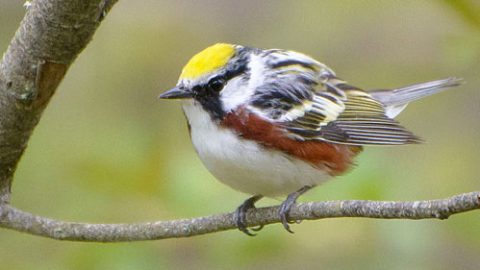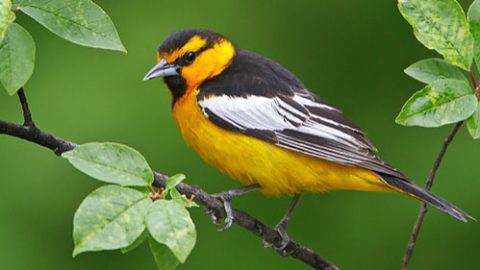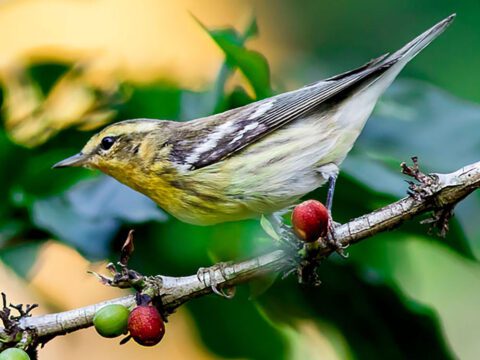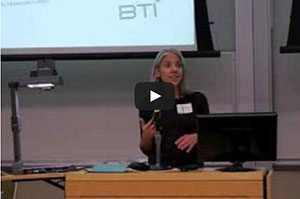Making Sense of Coffee Labels: Does Your Coffee Support Wintering Warblers?
By Gustave Axelson
October 9, 2012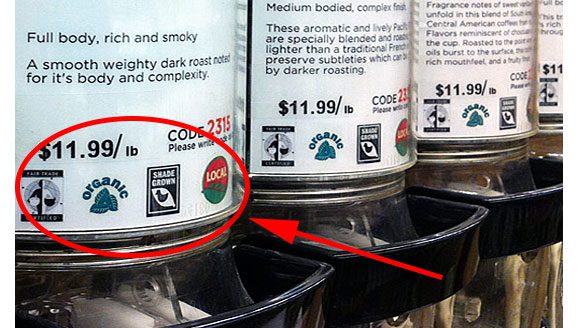
Imagine you walk into the neighborhood coffee house for your morning cup of joe, and on the counter is a tip jar with a sign reading, “$ for wintering warblers” with a photo of a Chestnut-sided Warbler in a tropical forest. You’d drop your change in, right? Any proud bird watcher would do their part for the wellbeing of the sprightly warblers that delight us so much come spring.
It’s not such a stretch of the imagination. Many of our most colorful songbirds, including warblers, tanagers, orioles, and grosbeaks, spend five months of the year in and around shade coffee plantations in Mexico and Central and South America—but only if the birds can find them. Shade-coffee plantations—particularly ones that grow coffee under a natural forest canopy—are increasingly being deforested, leaving North American migrants with fewer places to spend the winter.
The good news, says York University researcher Bridget Stutchbury, is that you can have your tasty roast and your songbirds too if you buy sustainable coffee, particularly Bird Friendly coffee. Stutchbury’s studies of Wood Thrushes show the sweet-singing birds of Eastern forests have declined by 50 percent since the 1960s. Yet, with regenerating forests in the Northeast, Wood Thrushes now have more breeding habitat than they did decades ago.
To look further, Stutchbury tracked individual Wood Thrushes from the U.S. to Nicaragua and back. She found that regional Wood Thrush population declines matched deforestation trends in Nicaragua, where forest cover has dropped 30 percent in just the past two decades. This deforestation likely affects other declining songbirds, too, such as Baltimore Orioles and Chestnut-sided and Kentucky warblers.
Can shade-grown coffee help these birds? Most coffee drinkers figure the answer is yes. But as it turns out, the words “shade-grown” on a package of coffee can refer to a range of habitat conditions that offer varying degrees of refuge for migratory songbirds.
Making Sense of Sustainable Coffee Labels
They’re those little rectangular icons lined up on your favorite gourmet coffee bags—a tree, a flower, a frog, a harvester, each trying to tell you something about how the coffee was grown. But what does each one mean, and how do they differ? Here’s a list of common labels and their benefits for birds. For more specifics, see the list of links below.
 Bird Friendly. Certified by scientists from the Smithsonian Migratory Bird Center, this coffee is organic and meets strict requirements for both the amount of shade and the type of forest in which the coffee is grown. Bird Friendly coffee farms are unique places where forest canopy and working farm merge into a single habitat. By paying a little extra and insisting on Bird Friendly coffee, you can help farmers hold out against economic pressures and continue preserving these valuable lands. The good news is that there’s more Bird Friendly coffee out there than many people realize—we just need to let retailers know we want it (see below).
Bird Friendly. Certified by scientists from the Smithsonian Migratory Bird Center, this coffee is organic and meets strict requirements for both the amount of shade and the type of forest in which the coffee is grown. Bird Friendly coffee farms are unique places where forest canopy and working farm merge into a single habitat. By paying a little extra and insisting on Bird Friendly coffee, you can help farmers hold out against economic pressures and continue preserving these valuable lands. The good news is that there’s more Bird Friendly coffee out there than many people realize—we just need to let retailers know we want it (see below). Organic. As with other organic crops, certified organic coffee is grown without most synthetic pesticides and fertilizers and is fairly sustainable—although there are no criteria for shade cover. Because of coffee’s growth requirements, it’s likely that organic coffee has been grown under some kind of shade, which is good. However, many farmers shade their coffee using other crops or nonnative, heavily pruned trees that provide substantially less habitat for birds, and the organic label offers no information about this.
Organic. As with other organic crops, certified organic coffee is grown without most synthetic pesticides and fertilizers and is fairly sustainable—although there are no criteria for shade cover. Because of coffee’s growth requirements, it’s likely that organic coffee has been grown under some kind of shade, which is good. However, many farmers shade their coffee using other crops or nonnative, heavily pruned trees that provide substantially less habitat for birds, and the organic label offers no information about this. Rainforest Alliance standards for shade cover are less stringent than Bird Friendly, but more than 70 percent of Rainforest Alliance certified farms maintain shade cover and the standard promotes preserving forest in reserves and along waterways. On farms where forest canopy is not the native ecosystem type, conservation area set-asides of 30 percent or greater are required in the standard.
Rainforest Alliance standards for shade cover are less stringent than Bird Friendly, but more than 70 percent of Rainforest Alliance certified farms maintain shade cover and the standard promotes preserving forest in reserves and along waterways. On farms where forest canopy is not the native ecosystem type, conservation area set-asides of 30 percent or greater are required in the standard. Fair Trade. Inspired by humanitarian concerns, Fair Trade labeling helps to ensure that the workers on coffee farms get paid fairly for the work they do. The higher prices that Fair Trade products earn help to provide an alternative to the price leverage that large coffee buyers can wield. However, a Fair Trade label does not convey any specific information about environmental practices.
Fair Trade. Inspired by humanitarian concerns, Fair Trade labeling helps to ensure that the workers on coffee farms get paid fairly for the work they do. The higher prices that Fair Trade products earn help to provide an alternative to the price leverage that large coffee buyers can wield. However, a Fair Trade label does not convey any specific information about environmental practices.- Shade-grown. “Shade-grown” labels often appear on specialty coffees, but unfortunately this designation is not regulated and doesn’t tell you much about the growing conditions at the farm. When the idea for Bird Friendly coffee was hatched by the Smithsonian Migratory Bird Center in 1996, plans for the certification process faltered while coffee companies quickly adopted the term “shade-grown” as a marketing buzzword. Unfortunately, this type of coffee can be grown among sparse trees on farms that lack diverse forest structure. Some shade-grown coffee is even grown under only the flimsy cover of banana trees fed artificial fertilizers and pesticides.
- “Specialty” just means the coffee scores 80 or higher on a tasting scale. It has nothing to do with environmental conditions, though specialty coffees do tend to come from smaller farms that often have some form of shade cover, which helps impart a richer flavor to the coffee.
- Sun-grown. Most coffee grown at an industrial scale is grown under full sun. Acres upon acres of coffee bushes planted in hedgelike rows are sustained by fertilizers, pesticides, and irrigation. Cheaper brands of coffee are likely produced with these methods and are unsustainable.
Related Stories
Bird Friendly Farmers Offer Half a Solution—We Can Be the Other Half
Bird Friendly certified coffee can be hard to find on store shelves and in coffee shops. One reason is that the standards for certification are so rigorous that only a small fraction of coffee farms can qualify. The total amount of Bird Friendly coffee certified in the past 12 years amounts to less than 2 percent of the Rainforest Alliance–certified coffee in 2011 alone.
But there’s another, paradoxical reason: coffee sellers don’t always advertise that their coffee is Bird Friendly. “Probably about only 10 percent of coffee from Bird Friendly certified farms carries the Bird Friendly stamp on the package,” says Robert Rice, a research scientist at the Smithsonian Migratory Bird Center.
For example, Starbucks and Whole Foods sell some coffee from Bird Friendly certified farms. But they don’t see the need to make room on their packaging for a separate label that appeals to a relatively small—and silent—minority: birders. And without the consumer demand and higher prices for Bird Friendly coffee, past history in Central America suggests that the market pushes coffee farmers toward partial-shade and sun-grown practices.
That’s understandable, Stutchbury says. “We can’t demand that they don’t cut down their forests, and give up money, unless we’re willing to give them something as compensation.” That’s the central idea behind Bird Friendly certified coffee: paying a price premium to growers on rustic coffee plantations so that they can continue to provide prime bird habitat.
The good news is, birders can make a difference—by asking retailers to stock Bird Friendly coffee, and by buying it. Think of it as a tip jar next to your coffee maker. More than 46 million Americans say they watch birds, and half of all Americans drink coffee. “If every birder in the U.S. committed to drinking Bird Friendly coffee, the market would grow 1,000-fold,” says Bill Wilson, owner of Massachusetts-based Birds & Beans, an online coffee retailer that specializes in selling only Bird-Friendly coffee.
Stutchbury says it’s time for birders to assert themselves in the coffee marketplace. “Buying Bird Friendly coffee is one of the best ways you can do your part to preserve wintering habitat for our migratory songbirds,” she said.
Where to Buy Bird Friendly Coffee
Grab a supply of Bird Friendly coffee—in a store or by ordering online—with the help of this locator from the Smithsonian Migratory Bird Center. Includes Bird-Friendly coffee options in the U.S., Canada, U.K., Czech Republic, and Japan.
More Resources on Coffee and Bird Habitat
- For much more detail about coffee labels and their meaning visit the Coffee and Conservation blog, operated by University of Michigan biologist Julie Craves.
- Not all coffee retailers advertise that their coffee is Bird Friendly. If you’re unsure whether your favorite coffee source is Bird Friendly, you can check this list of certified Bird Friendly farms organized by country.
- The Committee for Environmental Cooperation is a joint effort by the governments of Canada, Mexico, and the United States. They provide background on sustainable coffee and a wealth of information and research.
- Read more about Bird Friendly coffee farms in Nicaragua in our Living Bird magazine.
- Watch conservation scientist Amanda Rodewald’s basic primer on coffee cultivation and bird habitat in our post Basics of Bird-Friendly and Shade-Grown Coffee.

All About Birds
is a free resource
Available for everyone,
funded by donors like you
American Kestrel by Blair Dudeck / Macaulay Library

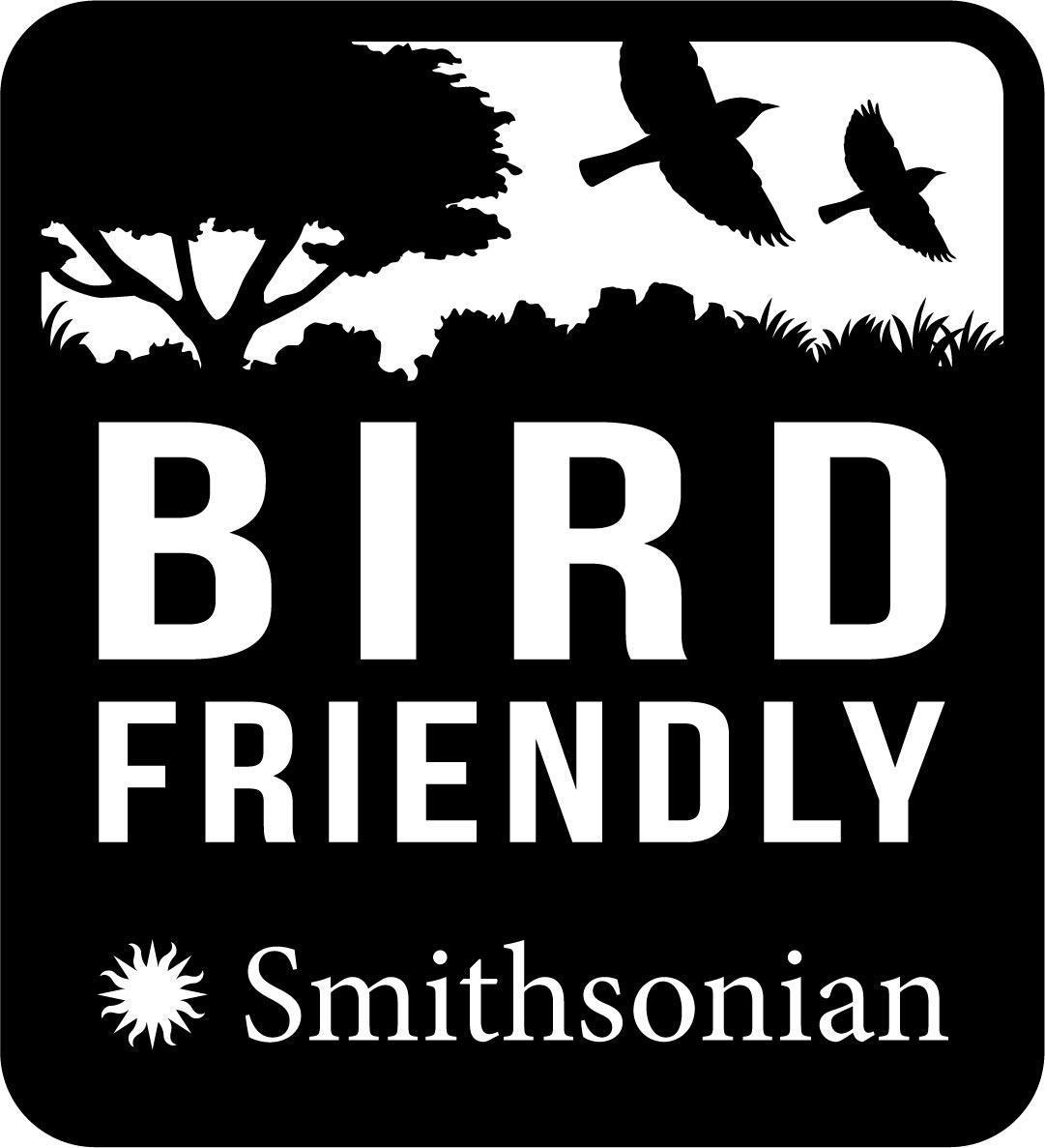


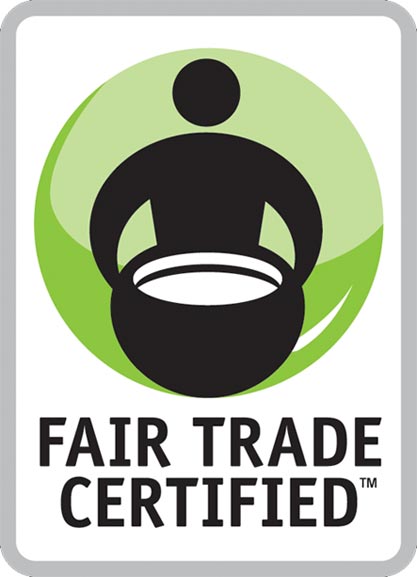 Fair Trade. Inspired by humanitarian concerns,
Fair Trade. Inspired by humanitarian concerns, 